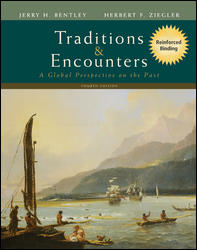Traditions and Encounters, 4th Edition (Bentley)Chapter 35:
THE AGE OF ANXIETYOverviewThe decades between the two world wars were neither peaceful nor prosperous. These were anxious, uncertain years. Old certainties were shaken; the liberal ideals of the Enlightenment lost their potency. After 1929, a global depression intensified the social and political unrest, and new extreme ideologies gained momentum. Common elements of this "age of anxiety" include: - Disillusionment. The harsh realities of trench warfare shattered the illusions of many young intellectuals. The culture of the 1920s is characterized by uncertainty and experimentation. Old truths in science, art, and religion were challenged. Nothing seemed certain anymore.
- Political extremism. The momentum of the nineteenth century had been toward democracy and greater inclusion of the poor, minorities, and finally women in the political process. In desperate times, many found democracy too inefficient and sought simple solutions in charismatic dictators.
- Extreme nationalism. The Paris peace settlements both aroused and disappointed nationalist hopes, especially in Italy, Japan, and Germany. Nationalists in these countries were frustrated at being denied territory considered rightly theirs. These frustrations were channeled into militaristic parties: the Fascists and the Nazis.
- The communist alternative. The world watched, in horror and fascination, as the communist experiment unfolded in the Soviet Union. In spite of appalling losses through civil war, forced collectivization, and political purges, the Soviet Union did appear to deliver a basic living to all citizens. With capitalist nations slumped in depression, this was an intriguing alternative. Communism was violently attacked in Italy and Germany.
 | 
















